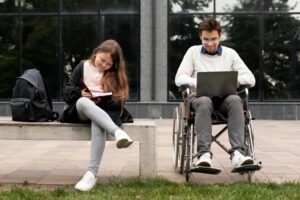Is my classroom accessible and inclusive?
Materials
1. The Interplay of Physical Spaces and Digital Education: A Deep Dive into Successful Integrations
In the ever-evolving realm of higher education, the intersection of physical spaces and digital education has emerged as a defining factor in shaping student learning experiences. This exploration delves into the heart of successful integrations, examining how Higher Education Institutions (HEIs) have seamlessly interwoven physical and digital elements to foster enhanced student engagement and collaboration. Through in-depth case studies, we’ll uncover innovative practices that transcend traditional boundaries, offering a blueprint for institutions seeking to optimize their educational environments.
2. Case Studies: Unlocking the Secrets of Successful Integration
To truly understand the symbiosis between physical spaces and digital education, let’s embark on a journey through a case study that showcase how various HEIs have seamlessly integrated these elements into their educational frameworks. This case study serves as a testament to innovative practices that go beyond traditional boundaries.
In a leading university, a faculty-driven initiative aimed to transform traditional classrooms into collaborative spaces equipped with advanced digital tools. Through the strategic placement of interactive whiteboards and flexible furniture arrangements, instructors could seamlessly integrate digital content into their lectures. Institution XYZ successfully implemented blended learning models that seamlessly combined face-to-face interactions with digital tools. The institution invested in the creation of technology-rich learning hubs. These hubs were designed as versatile spaces, incorporating augmented reality (AR) and virtual reality (VR) technologies. As students engaged with digital simulations and interactive content, the physical space became a dynamic backdrop for immersive learning experiences. The result was heightened student engagement and a palpable enthusiasm for digital tools. The impact was profound, fostering active student participation and collaboration on digital platforms.
Having explored these case studies, it’s crucial to reflect on the profound effects they have on student engagement and collaboration within digital learning environments.
2.1 Enhanced Student Engagement:
Integrating physical spaces with digital education has the power to captivate students’ attention and immerse them in the learning process. The case studies reveal that when students encounter a well-designed physical environment that complements digital content, their engagement levels soar. Whether it’s through interactive displays, collaborative workstations, or immersive technologies, the physical setting plays a crucial role in holding students’ focus and interest.
2.2 Fostering Collaborative Learning:
Beyond individual engagement, the interplay of physical and digital elements encourages collaboration among students. The collaborative classroom redesign, for instance, allowed students to work together on digital projects, fostering teamwork and shared learning experiences. The technology-rich learning hubs similarly promoted collaborative problem-solving, as students navigated through virtual environments and collectively tackled challenges.
2.3 Striking the Balance:
While the impact of successful integrations is evident, it’s essential to strike a balance between physical and digital elements. The case study underscores the importance of thoughtful design that aligns with pedagogical goals. Overemphasis on technology, without considering the physical comfort and adaptability of the space, may hinder rather than enhance the learning experience.
3. Case Study: Aga Khan Academy, Mombasa, Kenya
The Aga Khan Academy includes educational facilities in the city of Mombasa, Kenya. It is part of a larger network called Aga Khan Development Network (AKDN) that operates mostly in Africa and Asia. Their goal is to deliver high quality education from pre-school to post graduate levels. This individual school issues a series of guidelines to follow that will lead to a positive classroom environment. Although this paper focuses on classes that are diverse in terms of cultural and religious backgrounds it still offers insight in how to create a classroom that fosters learning.
One key role is played by the teacher that needs to be sensible enough to their students so that they will feel in a safe environment. A safe environment makes students feel comfortable speaking up and thus resulting in better in-class engagement.
Another factor that is valued is respect. The teacher ought to make sure that their students engage with each other in a respectful way. Differences are not to be hidden but they need to be acknowledged and appreciated while making sure that all the people involved in the conversation feel safe.
4. Your Role in Creating Inclusive Digital Learning Spaces:
Creating inclusive digital learning spaces goes beyond the selection of tools and technologies. It encompasses a multifaceted approach that considers the diverse needs, preferences, and backgrounds of students. As an educator, your role in this endeavor is critical and multifaceted:
4.1 Curriculum Design and Content Accessibility:
Start by reflecting on your curriculum design. How can you ensure that the content is accessible to all students, regardless of their learning styles or abilities? Incorporating diverse resources, providing alternative formats, and using universal design principles are key strategies to consider.
4.2 Technological Literacy and Support:
Embrace your role as a guide in navigating the digital landscape. Enhance your technological literacy to effectively integrate digital tools into your teaching practices. Additionally, be a source of support for students who might face challenges in adapting to the digital learning environment.
4.3 Interdisciplinary Collaboration:
Collaborate with colleagues from different disciplines to incorporate diverse perspectives and approaches into your digital learning spaces. Interdisciplinary projects and shared resources can enrich the overall learning experience.
5. Tips for some Self-Guided Activities
5.1 Personal Reflection Journals:
Encourage educators to maintain personal reflection journals, where they document their experiences, challenges, and successes in creating inclusive digital learning spaces. Periodic self-assessment can foster continuous improvement.
5.2 Collaborative Online Forums:
Create online forums or discussion boards where faculty and staff can share insights, pose questions, and collaborate on addressing common challenges related to inclusive digital education.
5.3 Book Clubs and Webinars:
Initiate book clubs or webinars centered around literature on digital inclusivity. This allows for collective exploration of best practices and provides a platform for collaborative discussions.
5.4 Cross-Departmental Project Teams:
Form cross-departmental project teams to tackle specific initiatives related to digital inclusivity. This could involve redesigning a course collaboratively or implementing a new technology with inclusivity in mind.
5.5 Pilot Programs and Small-Scale Implementations:
Consider initiating pilot programs or small-scale implementations inspired by the successful case studies. This allows for experimentation, data collection, and gradual adjustments based on real-time feedback.
6. Conclusion
The integration of physical spaces and digital education is not merely a trend but a transformative force in higher education. As our case studies have illuminated, institutions that thoughtfully combine these elements create dynamic learning environments where students thrive. By enhancing engagement, fostering collaboration, and striking a balance between the physical and digital, HEIs can unlock the full potential of their students.
The journey towards creating inclusive digital learning spaces is an ongoing one. Educators play a pivotal role in shaping these spaces, and through curriculum design, technological literacy, and interdisciplinary collaboration, they can empower students to navigate the digital landscape with confidence. As we move forward, the lessons learned from successful integrations will serve as a guiding light, illuminating the path towards a future where physical and digital.
References
Aga Khan Foundation. (2008). Classroom guide to creating an inclusive learning environment. https://www.akf.org.uk/wp-content/uploads/2020/05/AKF-Inclusive-Classroom-Guide-final.pdf
Dewsbury, B. M. (2017). Context determines strategies for ‘activating’the inclusive classroom. Journal of microbiology & biology education, 18(3), 10-1128.
https://journals.asm.org/doi/abs/10.1128/jmbe.v18i3.1347
Nilholm, C., & Alm, B. (2010). An inclusive classroom? A case study of inclusiveness, teacher strategies, and children’s experiences. European journal of special needs education, 25(3), 239-252.
Penner, M. R. (2018). Building an inclusive classroom. Journal of Undergraduate Neuroscience Education, 16(3), A268.
https://www.ncbi.nlm.nih.gov/pmc/articles/PMC6153021/
Scott, T. M., Park, K. L., Swain-Bradway, J., & Landers, E. (2007). Positive behavior support in the classroom: Facilitating behaviorally inclusive learning environments. International Journal of Behavioral Consultation and Therapy, 3(2), 223.
https://psycnet.apa.org/record/2008-06147-004
3. Infrastructure and Equipment/ Tools and Technology
Accessible Infrastructure for Inclusive Education
IET 3.3
10 min
At the end of this Unit, you will be able to:
– Understand the impact of physical spaces on digital education.
– Explore practical strategies for creating inclusive learning environments.
– Reflect on your role in fostering collaboration and engagement.
tools, digital infrastructure, equipment, physical accessibility, Inclusive Digital Education, Student Engagement, Collaborative Learning, Flexible Classroom Designs,








Funded by the European Union. Views and opinions expressed are however those of the author(s) only and do not necessarily reflect those of the European Union or the European Education and Culture Executive Agency (EACEA). Neither the European Union nor EACEA can be held responsible for them (2022- 1 -SI01 -KA220-HED-000088368).






